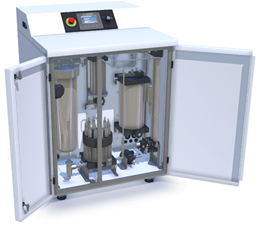Small-Capacity Hydrogen Generators for Laboratory Use
Electrolyzer-based hydrogen generators are often used to reduce laboratory gas inventory by generating hydrogen only as needed, especially when commercial hydrogen delivery and/or storage is not practical. Use of a suitable electrolyzer/hydrogen generator will allow automated generation of flow/pressure demand and can minimize concerns about gas purity and safe handling attributed to gas cylinder supply change reconnection.
To prevent the possibility of pumping hydrogen into a non-ventilated space, the electrolyzer should automatically shut down if
- there is a ventilation system outage, or
- a laboratory sensor detects hydrogen in the air.
Best practice includes use of agency certified/listed units (e.g., ISO 22734, CSA/ANSI 22.2 No. 22734, or IEC 61010-1).
Cord-connected bench-top appliances typically have very small H2 generation capacities useful for laboratory chemical analysis. Larger capacity direct-wired systems may be specified where greater hydrogen generation rates are required, such as sub-scale fuel cell testing.
Electrolyzer-based hydrogen generators should be installed in accordance with manufacturer instructions. General guidance for installation includes the following:
- Install in a non-classified area that is ventilated with fresh air per manufacturer requirements – for instance, not in an enclosed unventilated equipment closet.
- Vent waste hydrogen to a safe hydrogen exhaust vent. See Venting.
- Vent waste oxygen to a separate safe exhaust vent or assure that local air ventilation provides sufficient dilution (less than 23.5% O2 in air per NFPA 2 2020, 13.3.1.2.2.
- Small units often dilute waste oxygen with enclosure vent air.
- Larger units may require oxygen-compatible vent piping to a safe exhaust vent.
- Interlock with lab alarms – ventilation, combustible gas, fire – to stop hydrogen and oxygen generation.
References
CGA G5.5, Hydrogen Vent Systems
CHS Webinar: Safety of Water Electrolysis
CSA/ANSI 22.2 No. 22734 (to be published in 2023)
EIGA Doc 154 09 E, Safe Location of Oxygen and Inert Gas Vents
EIGA Doc 211 17, Hydrogen Vent Systems for Customer Applications
IEC 61010-1, Safety requirements for electrical equipment for measurement, control, and laboratory use - Part 1: General requirements
ISO 22734, Hydrogen generators using water electrolysis — Industrial, commercial, and residential applications (current version 2019)
ISO/TR 22734-2, Hydrogen Generators Using Water Electrolysis – Part 2: Testing guidance for performing electricity grid service (to be published in 2023)
NFPA 2, Hydrogen Technologies Code
Safety Planning for Hydrogen and Fuel Cell Projects


